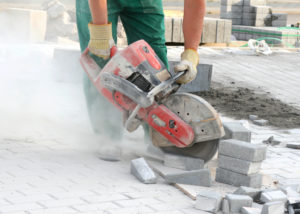Silicosis is a disease that destroys lung tissue. A new online tool helps employers protect workers from exposure to dusts that cause it.

Photo credit: iStock.com/Cebas
Whenever I hear about silica exposure, I’m reminded of the construction worker I wrote about in my post To mask or not to mask.
He was in a café, covered in grey dust after working beside a young guy using a jackhammer all day. He laughed when I asked how he protected his lungs from the stuff. “They offered me a mask, but I just said: ‘Look at all this nose hair! I’m old [early 40s?] and I grow a lot of nose hair now, so I might as well use it for something!’”
I felt so worried for this stranger. I had been reading about exposure to silica dust released from construction materials such as rock, concrete, tile, and brick. Workers who grind, cut, and haul these materials are at risk of developing silicosis – a disease that destroys lung tissue and impairs a person’s ability to breathe. It usually takes many years (or even decades) to develop.
But before I could formulate any kind of warning, the worker got up, went outside, and lit a cigarette.
Tool helps employers develop silica control plan
B.C. employers must protect workers exposed to silica by developing a silica exposure control plan.
To make this task easier, the BC Construction Safety Alliance (BCCSA), in collaboration with WorkSafeBC and the University of B.C., created a Silica Control Tool.
Mike McKenna, the BCCSA’s executive director, described to me how the tool helps employers keep workers safe and demonstrate their compliance with the Occupational Health and Safety Regulation in our province.
Employers can access the tool via smart phone, tablet, or computer. They enter details about a specific task, including what controls they are using to mitigate risk. From this data, the tool generates an exposure level. If it’s above the allowable limit, employers can try out different controls to see how they can reduce the exposure level, before saving their customized control plan.
“The tool then allows you to push a button, and your exposure control plan comes out. It spits out all the paperwork necessary for WorkSafeBC officers to know you’ve done your due diligence,” Mike says. “That doesn’t mean the WorkSafeBC officer isn’t going to ask you questions like ‘How did you come to this determination? Walk me through your process.’”
But the tool goes through everything necessary to comply with the silica part of the Regulation. So Mike isn’t surprised that the tool has been really successful and “usage has been through the roof.”
You can read more about the tool in this article in the May/June 2017 issue of WorkSafe Magazine.
For more information, see Silica from WorkSafeBC, along with my other posts on this important topic:
Is rock dust the new asbestos?
Raising awareness of silicosis


